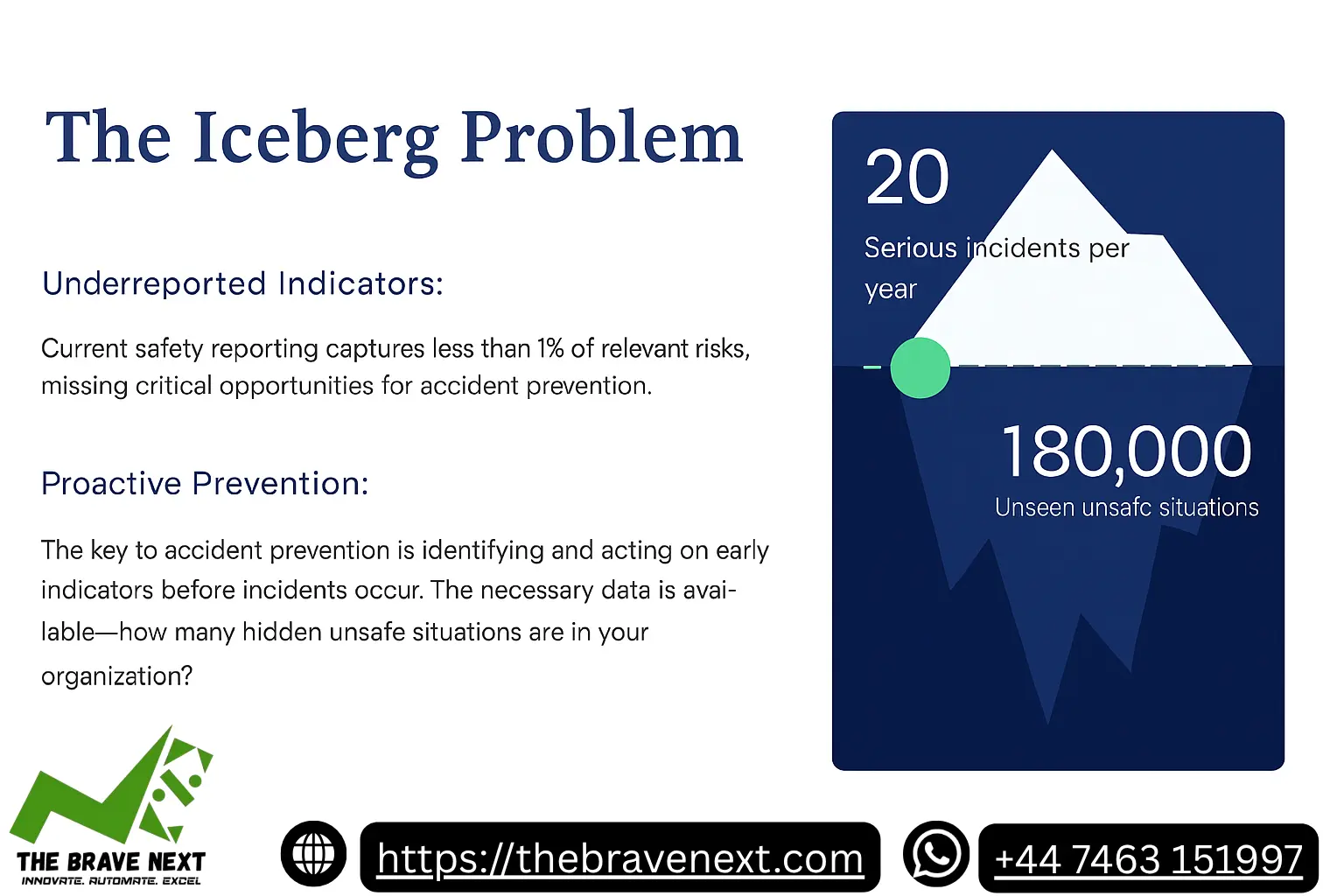

In many workplaces, safety is measured by visible incidents—accidents, injuries, or near misses. But these are only the tip of the iceberg. Beneath every reported incident lies a hidden mass of unsafe behaviors, unaddressed hazards, and systemic weaknesses. This is known as the "Iceberg Problem" in workplace safety: the idea that what you don't see (or report) can be far more dangerous than what you do. Understanding and addressing this hidden layer is essential to building a truly safe and resilient work environment.
The iceberg model suggests that for every visible accident or injury, there are many more unreported or unnoticed unsafe acts and conditions. Like an iceberg, only a small portion is visible above the surface—while a much larger and more dangerous portion remains hidden below.
Unseen safety risks may not cause immediate harm, but they silently erode the workplace environment. Left unchecked, these hazards can escalate into serious incidents, leading to injury, financial losses, or reputational damage.
Near misses are incidents that didn’t result in injury—but could have. These are warning signs that something is wrong. Tracking and analyzing near misses helps identify patterns and prevent future accidents.
Fear of retaliation, lack of trust, or simply the belief that "it’s no big deal" can stop workers from reporting hazards. Encouraging a culture of openness and trust is key to surfacing the hidden parts of the safety iceberg.
Unsafe conditions (like faulty machinery) are easier to identify, but unsafe behaviors (like taking shortcuts or skipping safety checks) are often hidden and more frequent. Both must be addressed to improve safety outcomes.

Leaders must look beyond safety reports and actively engage with employees to understand what’s really happening on the ground. Site walks, open forums, and anonymous reporting tools help uncover hidden issues.
Effective safety training should not be a one-time event. Ongoing education, real-world simulations, and clear communication can help employees recognize and report hazards—before they turn into incidents.
Using safety data analytics can help spot trends and risks that might otherwise go unnoticed. By analyzing patterns in near misses, minor incidents, and behavioral observations, companies can identify high-risk areas proactively.
A strong safety culture empowers every employee to speak up about concerns without fear. Recognition programs, safety champions, and open-door policies foster a workplace where invisible risks become visible—and manageable.
Acknowledging and addressing the full iceberg—not just the visible tip—is what separates reactive safety programs from truly proactive ones. When organizations take a deeper, more holistic approach to safety, everyone wins.
Workplace safety isn’t just about preventing accidents—it’s about uncovering the hidden factors that lead to them. By understanding the Iceberg Problem and actively working to reveal what lies beneath, organizations can protect their people, preserve their productivity, and build a culture where safety is everyone's responsibility.
Our in-depth analysis of AI-driven workplace safety has been featured across respected publishing and industry platforms. You can explore the full article on:
The Iceberg Problem refers to the concept that visible safety incidents (like major injuries or accidents) are just the tip of the iceberg, while a much larger number of hidden or unreported issues—such as near-misses, unsafe behaviors, and minor injuries—lie beneath the surface. These hidden problems often go unnoticed but can indicate serious underlying risks that may lead to more severe incidents if not addressed.
Ignoring the hidden part of the iceberg is dangerous because near-misses and minor incidents often serve as early warning signs or precursors to major accidents. Beneath the surface, cultural and systemic issues—such as inadequate training, poor communication, insufficient safety reporting, or pressure to meet deadlines—can quietly develop and remain undetected. When these underlying risks go unaddressed, organizations may develop a false sense of security, leaving them vulnerable to unexpected and potentially catastrophic safety failures.
To effectively address the iceberg problem in workplace safety, organizations must foster a culture that encourages open communication and non-punitive reporting of hazards and near-misses. Building trust among employees ensures that risks are identified early. Utilizing data analytics can help track trends in minor incidents and highlight underlying patterns that may indicate deeper issues. Additionally, conducting regular safety audits, site observations, and proactive risk assessments helps bring hidden dangers to light. Equipping supervisors and teams with the skills to recognize early warning signs and take timely corrective actions is also essential for preventing small issues from escalating into serious incidents.
Please send your query or requirements in detail via whatsapp, and we will respond shortly.
Thank you!